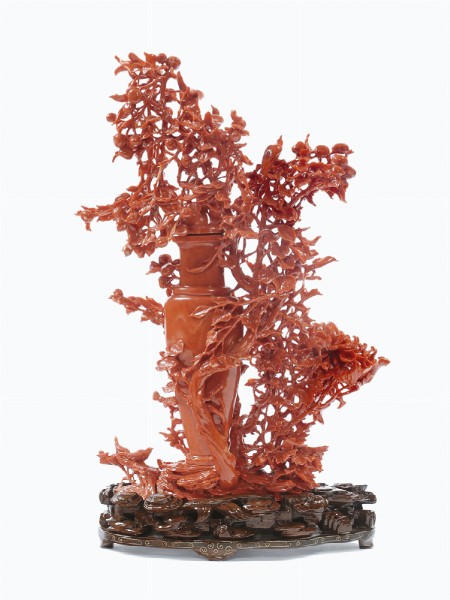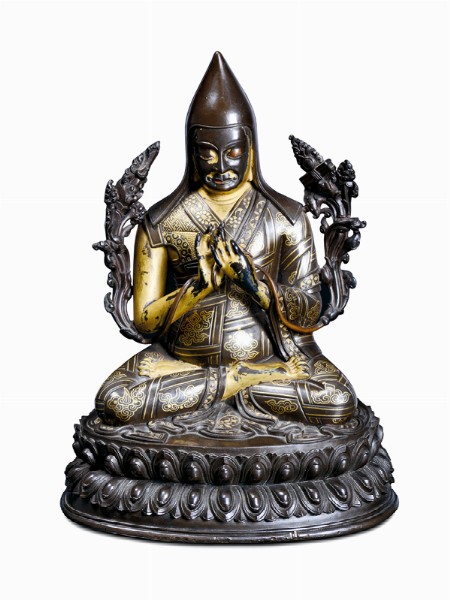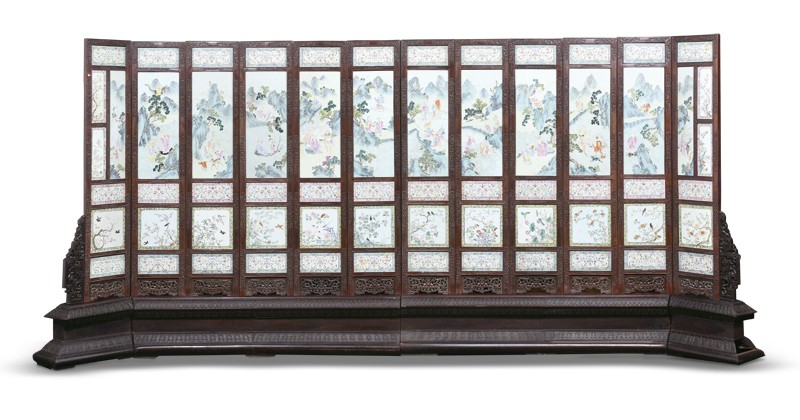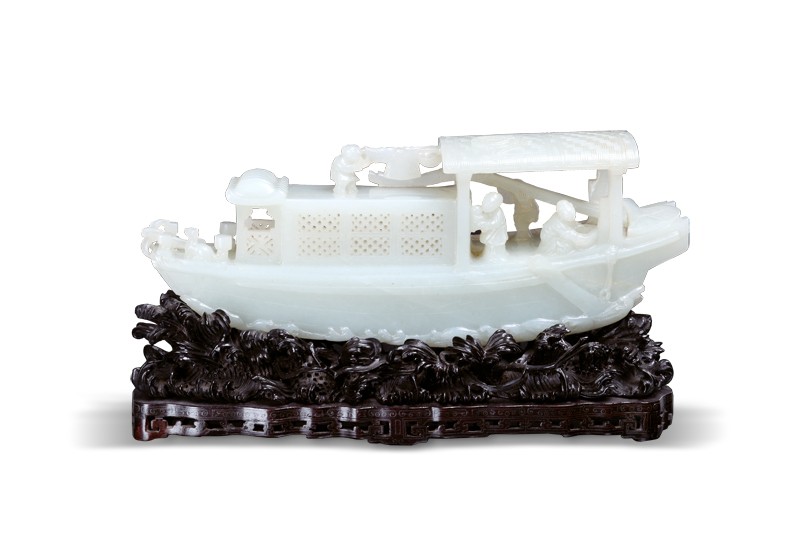
A red coral vase representing richly carved vegetation, fruit and birds

A rare and fine partially gilt bronze sculpture with gold marquetry representing Tsong-Khapa
Since the 1990s, and maybe also before, it was well known that China reserved some surprises, but only with the recent European economical crisis Chinese culture and economical power was able to come out into the open.
The last Fine Chinese Works of Art Auction, organised by Cambi last June, exceeded all expectations, confirming the Genoese auction house as point of reference for Oriental Art sales in Italy and abroad and putting the sales in this sector at the same level as those of Christie’s and Sotheby’s in London.
Numbers are clear: from an initial value of 2,600,000 euros, we reached a total of 6,630,000 euros of sales, realising 255% of the estimates and more than 50% of the lots sold. Considering the fact that more than 50% of these results came from the sale of a tenth of lots, it is clear that an able and accurate selection of the works really makes the difference.
Nine lots were sold for more than 100,000 euros. Among the porcelains, a white and blue cachepot was sold for 115,000 euros, while a marble Loan head, on the cover of the catalogue, was sold for 130,000 euros. The most expensive coral was a group representing a vase immersed in many flowering racemes and for the peculiarity of the subject represented, realised with a particular care for the details, it was sold for 135,000 euro.
Then, other important adjudications were represented by the jades, a characteristic oriental art production, with three extremely rare lots: a sculpted plate with a wooden carved base sold for 160,000 euros, a small group representing three horses sold for 172,000 euros and a small ship model sold for 200,000 euros.
Two bronze sculptures mounted the podium: a large Buddha on a lotus flower, Ming Dynasty, 17th century, 72 centimetre high, sold for 220,000 euros, while a small rare representation of Tsong-Khapa, finely decorated with golden inlays, Qing Dynasty, Qianlong Period (1736–1795), was sold to a passionate collector for 290,000 euros.
The real surprise, which astonished all the people in the room and those who were following the auction by phone and the web (and the person who gave us the object to be sold) was the homu twelve-shutter screen, formed by 64 polychrome porcelain plates finely decorated with people and landscapes and rich floral elements, in the colours of the Famille Rose, Qing Dynasty, Qianlong Period (1736–1795).
This beautiful object was inserted in the catalogue with a conservative estimate of 12,000-15,000 euros, but during the weeks before the auction we had some confirmations of the extraordinary value of this object.
The auctioneer had started the sale of this object from a few seconds when the first offer was placed: 500,000 euros. After a few moments of surprise for the “exuberant” start, many other offers followed to reach the final adjudication sum of 2,070,000 euros, with which the Auction House Cambi, for the third time, raised the Italian record for the sale of an oriental art object.
Cambi therefore obtained an important result, standing in front of Christie’s (1,394,000 euros) for the highest hammer price of the semester for the oriental art.
The next auction is planned for december 17th, as in 2012, and who knows if it will be able to confirm the positive trend started exactly in that year?
The last Fine Chinese Works of Art Auction, organised by Cambi last June, exceeded all expectations, confirming the Genoese auction house as point of reference for Oriental Art sales in Italy and abroad and putting the sales in this sector at the same level as those of Christie’s and Sotheby’s in London.
Numbers are clear: from an initial value of 2,600,000 euros, we reached a total of 6,630,000 euros of sales, realising 255% of the estimates and more than 50% of the lots sold. Considering the fact that more than 50% of these results came from the sale of a tenth of lots, it is clear that an able and accurate selection of the works really makes the difference.
Nine lots were sold for more than 100,000 euros. Among the porcelains, a white and blue cachepot was sold for 115,000 euros, while a marble Loan head, on the cover of the catalogue, was sold for 130,000 euros. The most expensive coral was a group representing a vase immersed in many flowering racemes and for the peculiarity of the subject represented, realised with a particular care for the details, it was sold for 135,000 euro.
Then, other important adjudications were represented by the jades, a characteristic oriental art production, with three extremely rare lots: a sculpted plate with a wooden carved base sold for 160,000 euros, a small group representing three horses sold for 172,000 euros and a small ship model sold for 200,000 euros.
Two bronze sculptures mounted the podium: a large Buddha on a lotus flower, Ming Dynasty, 17th century, 72 centimetre high, sold for 220,000 euros, while a small rare representation of Tsong-Khapa, finely decorated with golden inlays, Qing Dynasty, Qianlong Period (1736–1795), was sold to a passionate collector for 290,000 euros.
The real surprise, which astonished all the people in the room and those who were following the auction by phone and the web (and the person who gave us the object to be sold) was the homu twelve-shutter screen, formed by 64 polychrome porcelain plates finely decorated with people and landscapes and rich floral elements, in the colours of the Famille Rose, Qing Dynasty, Qianlong Period (1736–1795).
This beautiful object was inserted in the catalogue with a conservative estimate of 12,000-15,000 euros, but during the weeks before the auction we had some confirmations of the extraordinary value of this object.
The auctioneer had started the sale of this object from a few seconds when the first offer was placed: 500,000 euros. After a few moments of surprise for the “exuberant” start, many other offers followed to reach the final adjudication sum of 2,070,000 euros, with which the Auction House Cambi, for the third time, raised the Italian record for the sale of an oriental art object.
Cambi therefore obtained an important result, standing in front of Christie’s (1,394,000 euros) for the highest hammer price of the semester for the oriental art.
The next auction is planned for december 17th, as in 2012, and who knows if it will be able to confirm the positive trend started exactly in that year?

